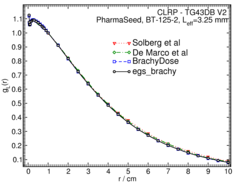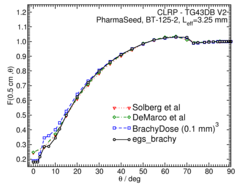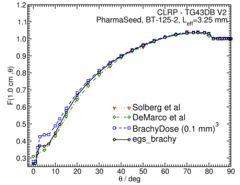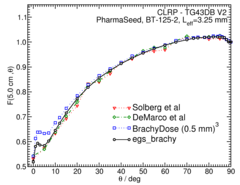
Source Description:
The PharamSeed BT-125-1 source 1, 2 dimensions are taken from the studies by Solberg et al 1 and Demarco et al 2. The source element for the PharmaSeed is a cylindrical silver rod with an outer diameter of 0.500 mm and a length of 3.25 mm. The rod is coated with a 0.50 μm thick layer of 125I. The titanium encapsulation has a 0.80 mm outer diameter and is 0.060 mm thick. End welds are 0.50 mm thick and are modelled in this study as a cylinder and have a 0.40 mm radius (Note:The CLRPv1 database mistakelly modeled the endcaps as hemisphers, which cause a change of about 10% in the anisotropy function close to the end caps at angles from 0° - 20°). The BT-125-2 source is identical to the BT-125-1 source with the exception that the cylindrical rod is made of silver rather than palladium. The overall source length is 4.50 mm and the active length of both sources is 3.25 mm. The cylindrical source element can move 0.124 mm along the seed axis and 0.090 mm radially from the center of the seed, however, we assume the source element is always centred. The mean photon energy calculated on the surface of the source is 27.35 keV with statistical uncertainties < 0.010%.
Note: The 2D anisotropy function values, F(r ≤ 5 cm, θ ≤ 15 °), differ by up to 35% (on average 10%) from the CLRPv1 database due to CLRPv1's geometry differences (i.e., end caps are modelled as hemispheres). In this update they are modelled as full cylinders according to the DeMarco et al 2 and Solberg et al 1 descriptions.
Dose-Rate Constant - Λ :
Dose-rate constants, Λ , are calculated by dividing the dose to water per history in a (0.1 mm)3 voxel centered on the reference position, (1 cm,Π/2), in the 30x30x30 cm3 water phantom, by the air-kerma strength per history (scored in vacuo). As described in ref. 3, dose-rate constants are provided for air-kerma strength calculated using voxels of 2.66x2.66x0.05 cm3 (WAFAC) and 0.1x0.1x0.05 cm3 (point) located 10 cm from the source. The larger voxel size averages the air-kerma per history over a region covering roughly the same solid angle subtended by the primary collimator of the WAFAC 4, 5 at NIST used for calibrating low-energy brachytherapy sources and is likely the most clinically relevant value. The small voxel serves to estimate the air kerma per history at a point on the transverse axis and includes a small 1/r2 correction (0.5%) 3. MC uncertainties are statistical uncertainties only (k=1).
Radial dose function - g(r):
The radial dose function, g(r), is calculated using both line and point source geometry functions and tabulated at 36 different radial distances ranging from 0.05 cm to 10 cm. Fit parameters for a modified polynomial expression are also provided 8. The mean residual deviations from the actual data for the best fit were < 0.16%.
| Fitting coefficients for g L (r) = (a0 r-2 + a1 r-1 + a2 + a3r + a4r2 + a5 r3) e-a6r | |||
| Fit range | Coefficients | ||
| r min (cm) | r max (cm) | ||
| 0.05 | 10.00 | a0 / cm2 | (7.63+/-0.18)E-04 |
| a1 / cm | (-1.80+/-0.04)E-02 | ||
| a2 | (1.1737+/-0.0023)E+00 | ||
| a3 / cm-1 | (3.61+/-0.13)E-01 | ||
| a4 / cm-2 | (-1.08+/-0.22)E-02 | ||
| a5 / cm-3 | (1.20+/-0.10)E-03 | ||
| a6 / cm-1 | (4.12+/-0.09)E-01 | ||
Anisotropy function - F(r,θ):
Anisotropy functions are calculated using the line source approximation and tabulated at radii of 0.1, 0.15, 0.25, 0.5, 0.75, 1, 2, 3, 4, 5, 7.5 and 10 cm and 32 unique polar angles with a minimum resolution of 5 o . The anisotropy factor, φ an (r), was calculated by integrating the solid angle weighted dose rate over 0 o ≤ ϑ ≤ 90 o .
Tabulated data:
Tabulated data are available in .xlsx format: Excel
References:
1. T. D. Solberg et al , Dosimetric parameters of three new solid core 125I brachytherapy sources, J. Appl. Clin. Med. Phys, 3 , 119-134, 2002
2. J. J. DeMarco et al , Dosimetric characteristics for three low-energy brachytherapy sources using the Monte Carlo N-Particle code, Med. Phys., 29 , 662 - 668, 2002
3. R. E. P. Taylor et al , Benchmarking BrachyDose: voxel-based EGSnrc Monte Carlo calculations of TG-43 dosimetry parameters, Med. Phys., 34 , 445 - 457, 2007
4. R. Loevinger, Wide-angle free-air chamber for calibration of low-energy brachytherapy sources, Med. Phys., 20 , 907, 1993
5. S. M Seltzer et al , New National Air-Kerma-Strength Standards for 125I and 103Pd Brachytherapy Seeds, J. Res. Natl. Inst. Stand. Technol., 108, 337-358, 2003
6. H. Safigholi, M. J. P. Chamberland, R. E. P. Taylor, C. H. Allen, M. P. Martinov, D. W. O. Rogers, and R. M. Thomson, Update of the CLRP TG-43 parameter database for the brachytherapy, to be published (Current calculation).
7. R. E. P. Taylor, D. W. O. Rogers, An EGSnrc Monte Carlo-calculated database of TG-43 parameters, Med. Phys., 35 , 4228--4241, 2008
8. R. E. P. Taylor, D. W. O. Rogers, More accurate fitting of 125I and 103Pd radial dose functions, Med. Phys., 35 , 4242--4250, 2008
May 5, 2020



